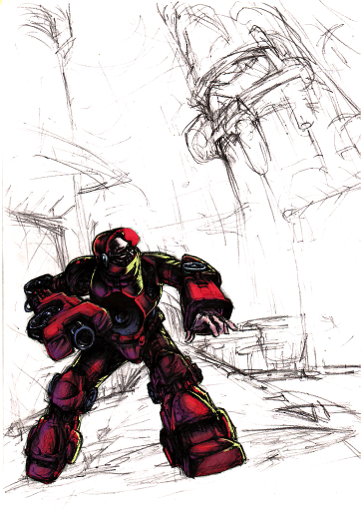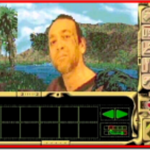The computer and video games market is worth billion $$$ and meanwhile superceded the annual turnover of the major studios in Hollywood. Successful franchises like Might & Magic, Ultima or Final Fantasy touch generations of fans – some were started 30 years ago and still see new sequels every now and then.
Gamers show an astonishing degree of loyalty, but even though every hardware generation makes new effects possible and allows for a better immersion into the game world, it is not only the latest in technology that attracts many. Retro-games for example also have a very strong and loyal followership. While their hardware base may be long out of production, there are still new games being developed for consoles like the Atari 2600 or the Intellivision although they were introduced in the late 70s and went out of production in the course of the neon-lit 1980s.
Who are these people that develop games for abandoned consoles? Why are they working on dated hardware with many technical limitations compared to even today´s smartphones while at the same time they could spend their time developing games for Android or iOS?
We are very grateful that some of the most prominent developers from the Atari sector took the time to answer some questions, Johannes and Roland Graf of Duranik and Carl Forhan of Songbird-Productions. Duranik developed some of the highest ranked games for the Atari Jaguar and Atari Lynx like „Alpine Games“, Carl Forhan is also developing games but is rather a huntsman of lost digital treasures – he tracks down unfinished and unpublished games and finalizes and publishes them, which is to some degree comparable to the work of a restorer of lost or hidden mural paintings, wiping away the sands and dust of time, bringing them back to life and making them shine in vibrant colours again. Carl brought „Cyber Virus“ to the Lynx and „Skyhammer“ to the Jaguar (amongst others). Retro games often utilize a console´s technical possibilities to the max.
From left to right: Carlf Forhan (Songbird Productions), Johannes Graf & Roland Graf (Duranik)
For a better understanding we must not forget that the Atari Lynx was introduced in 1989 alongside Nintendo´s Gameboy, outmatching its little grey adversary in every respect from speed to colours to soundquality and design. The Atari Jaguar was introduced in 1993 and was Atari´s last attempt to gain ground in the home consoles market – before it eventually closed down in 1995. Today´s Atari has nothing to do with the gaming veteran from the arcades of the 1970s – it is a rebadged French games company formerly known as Infogrames.
A fascinating example for the power of retro-games is Eric Chahi´s „Another World“. First being published in 1991 it stands for a totally new approach on atmospheric adventure games. In 2012 it was chosen for display in the video game art exposition by the Museum of Modern Art in New York and just recently an officially acknowledged version for the Atari Jaguar was released offering the best features of all other versions for consoles or home computers so far.
Can you briefly introduce yourselves and tell us about the work people associate you with most?
CARL: My name is Carl Forhan, but many people call me „Songbird“ since my hobby company, Songbird Productions, publishes video games for the very old Atari Lynx and Jaguar systems.
DURANIK: We have been around for quite some time now mostly working on old Atari machines. As we are two brothers, each one is doing a different part, more or less split into coding and graphics/level and game design.
We have done some work on the Atari Falcon and Atari Jaguar many years ago. On the Jaguar we worked on a game called „Native“ unfortunately this was never finished. Lately we have released a game on the Dreamcast called „Sturmwind“.
What makes it so interesting to work for a retro-console or retro computers? What is a retro-console anyways?
CARL: A retro console is basically a game system which is no longer supported by the publisher, and typically a few years have passed since the last official game publication. In my mind, that includes any console ever published by Atari. 🙂 But many gamers would include the early Sega and Nintendo systems in that as well. It seems kind of surreal to think that the original Xbox could be considered a retro-gaming console, but I suppose it’s possible. 😉
DURANIK: Well most people working on these machines have fond memories of those times because they were young or at least younger 😉 back than. Computer and Video games were new and something special. To be honest we wouldn’t work on such a retro console if we wouldn’t have a personal „relationship“ with the machine. This means having owned one or played with it at some friends place.
Well, a retro console is an abandoned old piece of hardware with some restrictions in memory/cpu/processing capabilities i guess 😉
CARL: I find it interesting to work on older systems because a) I’ve always been an Atari fan, and b) it’s fun to support these abandoned systems with new games for the fans who still enjoy them.
Video-Review of Songbird´s SKYHAMMER (Atari Jaguar)
You both are working in different areas: Duranik is developing games for abandoned Atari systems while Songbird completes and publishes own games and new releases.
The amount of information on these consoles must be ageing and limited to what is currently available for other platforms. Isn’t it harder to develop for retro-consoles than for newer systems?
CARL: Actually I have done both original game programming (see Remnant and Ponx) as well as publication of „lost“ games. I don’t know if it’s really harder to develop for an older system, as most of the technical documentation has made it onto the web, and other hobby developers have been kind enough to release compilers, linkers, and other tools to make life easier.
DURANIK: I find its the opposite around, information on these machines gets better all the time, there are lots of peoples working on tools and sharing their knowledge on the internet. If you were a developer back in the 90s for lets say the Jaguar or Genesis I guess you would know half of the stuff that’s available now, simply because you were limited to the developer documents that were available and of course there was no „google“ to help you out.
Because of that I don’t think its harder to develop for old machines compared to newer systems. Producing and publishing is another story, of course its much harder to make/sell a cartridge in a small quantity compared to a digital download.
Tracking down the rights of abandoned developments must be a pain. Is it? Or does it rather feel like being a modern day digital Indiana Jones, undusting ancient artifacts?
CARL: Personally, I have really enjoyed „the hunt“ of tracking down lost games and licensing them  for publication. Most former Atari developers are pretty happy just to see someone enjoying their games which never made it out in those days. It can be a long, slow process — Robinson’s Requiem took me years to finalize, for example.
for publication. Most former Atari developers are pretty happy just to see someone enjoying their games which never made it out in those days. It can be a long, slow process — Robinson’s Requiem took me years to finalize, for example.
… RR was originally released in 1994 by the now defunct company Silmarils and developed for the Jaguar but never released ….
CARL: But it’s always worth the wait. Now that we’re going on 20+ years since the Jaguar and Lynx were released, it is getting harder and harder to find anything, unfortunately. But you never know what may come around the corner. 😉
What is the typical customer of games for retro platforms? Is it an elderly person looking to refresh his memories or also younger ones, trying to experience what their parents felt while playing games?
Or maybe new audiences who weren´t playing before at all?
DURANIK: I would say its mostly people knowing the system from their younger years and of course collectors.
Its certainly not the super expert players. So the target audience is small in our experience, its collectors and or people still looking now and then if there is something new for their beloved system.
CARL: For my customers, I’ve definitely seen a mix of both 20+ year Atari veterans as well as new people just getting into the hobby.
There is a small but dedicated number of „classic gaming“ conventions where players and developers gather and share views, memories, experiences and opinions.
In which way are these conventions different from large-scale gaming expo’s?
DURANIK: Unfortunately we don’t have the time to visit a lot of the „classic gaming“ events like the „JagFest„. But from the pictures on the internet these events are small and „familiar“. Its more a come together and see each other again after a year went by.
You can not compare this to a event like the „gamescom„ for example.
CARL: I’ve been to some shows with under 100 people, and I’ve been to some shows with over 2000. You can tell there’s not as much „big money“ behind the shows, and they are much more a labor of love made possible with extensive volunteer support. But it is always amazing to see all these classic games and hardware lined up in one building for a weekend. There’s a strong sense of camaraderie among the vendors and attendees. I try to get to a show at least every 2-3 years so I can catch up with people I’ve known for 15+ years.
How much „fun“ is inside this business and how much „business“ comes with the fun? Means: is it worthwhile to work with, on or for retro-consoles or wouldn’t it be easier to publish games for modern OS’s and publish them via app-stores or portals like iTunes or Steam?
CARL: It’s always been a hobby. I have been fortunate in that my sales cover the cost of my hobby, but there’s no way I could make a living publishing games for ~200 active fans. I have no doubt I could release a game on a newer platform like Android or Steam, but at the same time, there would be a big learning curve which I’ve already done on the Atari systems. So I’m content to keep releasing games periodically when life permits it to happen. 🙂
DURANIK: Depends on what you want to do, if you want to earn money, of course these retro business is not the thing to get rich. The market is way too small and limited. Game sales from 200 – 3000 depending on the platform are not enough to make a living. Its a hobby for us, like other people are building model planes.
CARL: There are definitely parts of the hobby which are more work than fun. Packing boxes for shipping is always work. Even part of game development is more work than fun — testing the same level over and over again, adding title screens and option menus, and so on. It’s easy to get a fun idea for a game or even to get the basic engine running. Carrying it across the finish line so you can publish it for the fans is a lot more work.
10 best games for Atari Lynx
If somebody is new to retro-gaming, would you suggest to buy a console with a biographic / personal meaning, one that offers certain types of games or one that fits best inside ones living room?
CARL: If you’re going to buy a retro system, buy something either you enjoyed as a kid, or something which appears to have the style and genre of games you want. If you want Halo and Call of Duty FPS games, you’re not going to buy a NES. But if you enjoy 2D platformers and Tetris and the like, then it’s a great choice.
In my case, I grew up on the Atari 2600 and I will always love those games. There’s something about the „easy to play, hard to master“ style games where you could jump in with no prior skill and still have a good time. That’s what I try to carry forward into my publications for the Lynx and Jaguar.
DURANIK: Like I said above, I would buy something I know from the past. If you just buy a retro console and are only familiar with modern games, chances are high you will be disappointed. Of course it also depends on the games you like, for example if want to play jump and run type of games, you can not fail with snes/genesis etc.
Finally: If theres one game or product that you would like your grandkids to keep of you, which one would that be and why?
DURANIK: Of course they have to keep our Atari consoles, the Jag and the Lynx!
CARL: I would say my most popular game so far has been Protector for the Jaguar. It’s done really well and I am very happy with the way the game turned out. I took a game engine which was about 70% complete, fixed some bugs and fine-tuned the handling, then added a bunch of new waves and bosses and power-ups. It’s been a strong seller with the fans, and I just released a CD expansion called RESURGENCE about a year ago (12 years after Protector SE was first published!).
Carl, it is no secret that you are an active Christian. Does your personal faith have anything to do with your gaming activities?
CARL: As a Christian, I want my faith to influence everything I do. I want to treat people right because God has treated me right, and I want them to know His love because He showed love towards me through Christ. For Songbird, that mostly means handling the game properties with care and taking care of customers when something is missing or damaged or other issues. I also try to be sensitive with regards to the games I publish, and thus I prefer to avoid overly graphic or inappropriate content in my games.
(Interview: Stefan Piasecki)
LINKS:
Atari Gaming Headquarters AGH













